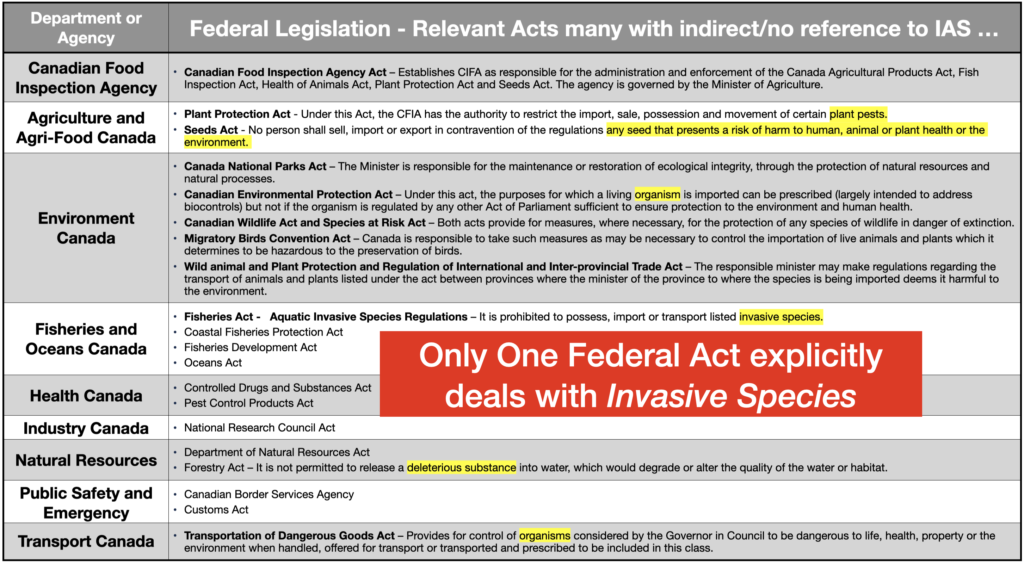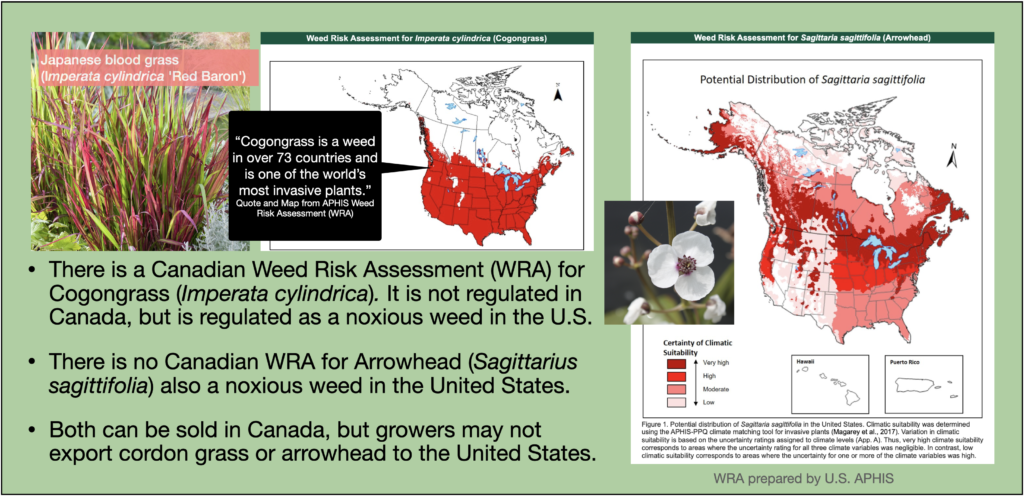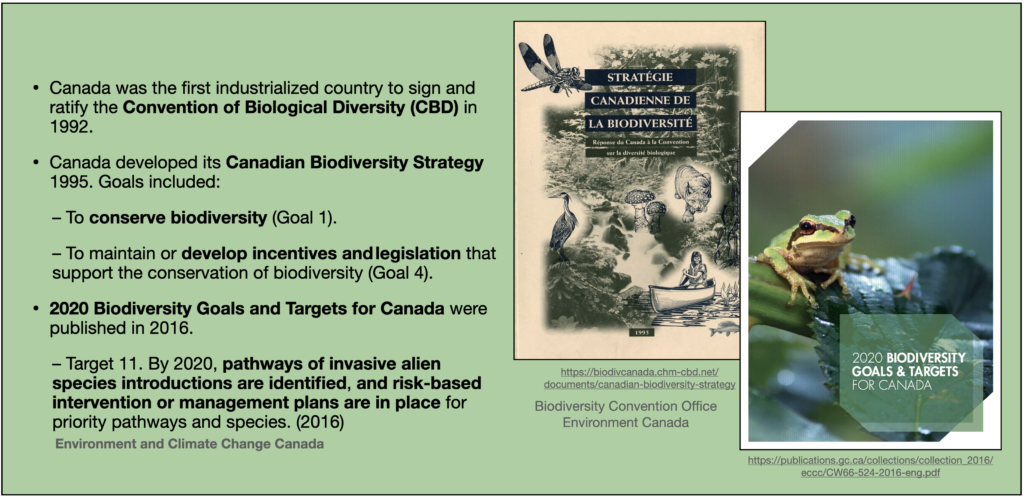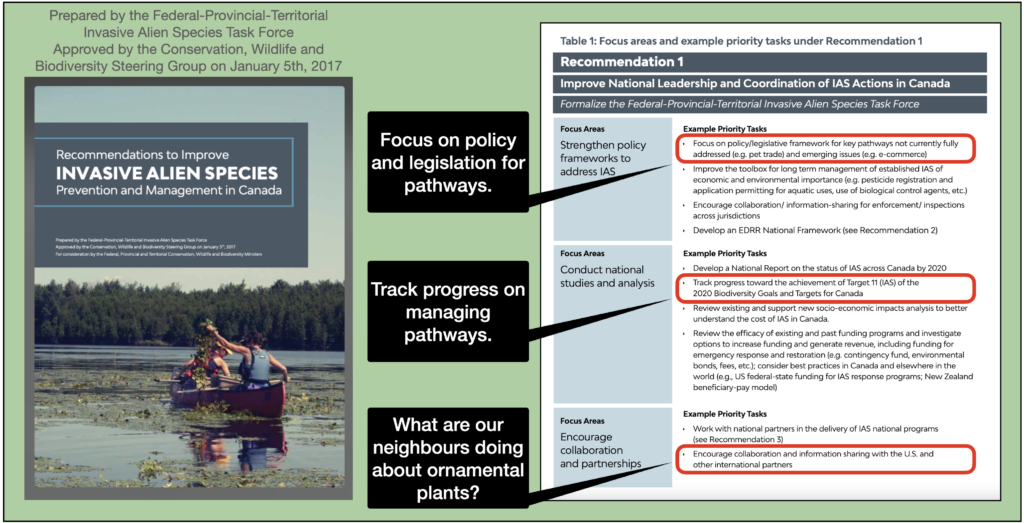Ornamental Plants classified as harmful Invasive Alien Species (IAS) are falling through regulatory gaps.
Let’s look at ten reasons why we need to improve our regulatory policies and processes:
- Horticulture is the most significant pathway for the introduction of Invasive Alien Plants.
- Canada’s legislative framework is out-of-date and fragmented.
- Responsibility is unclear.
- The Canadian Food Inspection Agency primarily regulates terrestrial plants that are domestically controllable and impact agriculture.
- Fisheries and Oceans fails to regulate invasive aquatic plants. (Fisheries and Oceans risk assessments for invasive plants are not in the Weed Risk Assessment database.)
- Canada does not have a comprehensive Plants of Canada Database with invasive plant ratings.
- Ontario is the only province with an Invasive Species Act.
- We are falling short of our obligations under the Convention on Biodiversity.
- We have not developed the regulatory tools called for in Canada’s Invasive Alien Species Strategy.
- We have not followed the recommendations of the Federal-Provincial-Territorial Invasive Alien Species Task Force to develop a policy/legislative framework to manage key pathways for invasive plant introductions, and to improve information sharing.

To learn more:
- In 2008, the horticultural industry was identified as the most significant pathway for the introduction of invasive alien plant species in Canada, (CFIA, Technical Report, 2008). No new regulatory tools were created to address this.
- “Canada’s legislative framework on IAS is fragmented, and this complicates the development of a coordinated approach to the problem.” (Smith et al., 2013). Canada needs to modernise federal regulations and improve Canadian invasive plant policies with regard to ornamental plants. Responsibility for regulating invasive plants is unclear.

- The Canadian Food Inspection Agency provides oversight for the management of terrestrial invasive plant species. The Plant Protection Act is used to restrict the import of “domestically controllable” invasive plants, (17 in total listed in 2022). The Seeds Act is used to restrict certain invasive species already present, like Purple Loosestrife (a Class 2 Noxious Weed). However, the latter legislation is inadequate for the task and mostly focuses on agricultural pest plants that contaminate grain seeds (weeds).
- “Fisheries and Oceans Canada was unclear on whether its responsibilities for regulating aquatic invasive species included freshwater plants,” (Auditor Report, Aquatic Invasive Species, 2019). The aquarium and ornamental pond industries have been identified “as the highest risk of IAS introductions,” (Kerr et al., 2005; Azan, 2011).
- Fisheries and Oceans have done some assessments of invasive aquatic plant species, but those evaluations are buried in papers, (Marson, 2009a; Marson, 2009b; Azan, 2011). Currently, provinces and territories rely on Invasive Plant Councils to identify invasive plants and educate the public about their risks. Unfortunately, Invasive Plant Councils are sometimes completely unfunded, underfunded or non-existent, (Yukon and Newfoundland have no councils; provincial funding for Ontario went from $100,000 to $0 in 2019). These organisations work hard to combat invasive plants, but have no power to prevent the sale or movement of these harmful plants. To reach the buying public, plants identified as risks by these councils should require labels.
- Canada does not have a comprehensive Plants of Canada Database with invasive plant ratings. CFIA does publish a Weeds Risk Database. There are over 400 species listed, but most lack a risk assessment and very few are present in Canada and in the horticultural or pet/aquarium trade. Canada needs a more comprehensive Plants Database with invasive plant ratings for plants in Canada and pre-risk assessments for plants imported for ornamental purposes. That database should include both terrestrial and aquatic species.

- Only Ontario has an Invasive Species Act. Other provinces have various Weeds Acts. The response to invasive plant species in the horticultural trade is extremely limited. The risk assessments done by Fisheries and Oceans Canada did bring some needed attention to invasive aquatic plants and several provinces have begun to regulate some that are in the horticultural and pet/aquarium trade. This highlights the fact that plants in the horticultural trade can be regulated and that federal risk assessments can be invaluable to provinces and territories.
- We have failed to meet our obligations under the 2010 Convention on Biodiversity – Target 9 states: “By 2020, invasive alien species and pathways are identified and prioritised, priority species are controlled or eradicated, and Aichi Biodiversity Targets measures are in place to manage pathways to prevent their introduction and establishment, (Aichi Targets; CBD Targets).

- We have yet to develop the regulatory tools called for in Canada’s Invasive Alien Species Strategy. “The use and enforcement of regulatory measures is an important component of managing the movement of invasive alien species both within and from outside Canada. …where feasible, federal departments and agencies and their provincial and territorial counterparts will develop legal and regulatory tools and amend existing legislation and regulations to strengthen measures to prevent, detect, respond, and manage invasive alien species.” (An Invasive Alien Strategy for Canada, 2004)
- The Federal-Provincial-Territorial Invasive Alien Species Task Force recommends that Canada:
- Focus on a policy/legislative framework for key pathways not currently fully addressed (e.g. horticultural and pet trade) and emerging issues (e.g. e-commerce).
- Track progress toward the achievement of Target 11 (which addresses Invasive Alien Species) of the 2020 Biodiversity Goals and Targets for Canada.
- Encourage collaboration and information sharing with the U.S. and other international partners. (Recommendations to Improve INVASIVE ALIEN SPECIES Prevention and Management in Canada, 2017).

Join us in asking our representatives to fix the regulatory gaps and improve policies and practices to stem the tide of invasive plant species in the horticultural and pet/aquarium trade.
